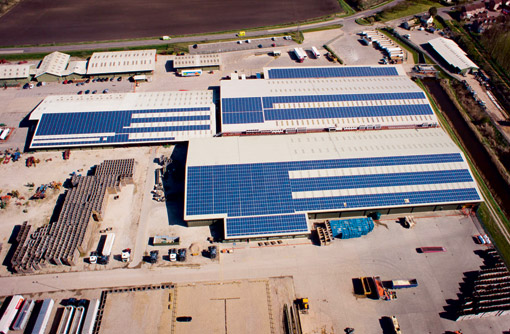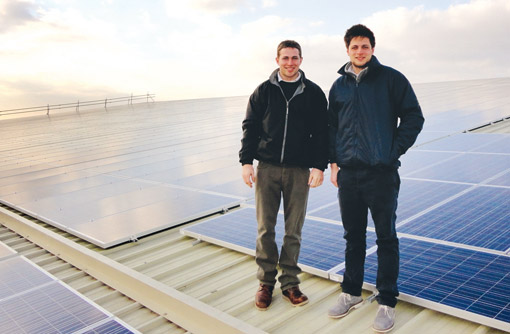Solar scheme slashes energy bill for veg grower

The UK’s largest privately owned roof-mounted solar PV installation is bringing energy savings and added income to one large-scale vegetable grower, as Aly Balsom reports
With more than 3,000sq m of fridge space alone, Alan Bartlett and Sons’ carrot and parsnip processing and packing plant has a hungry demand for electricity at all hours of the day and night.
Couple this with four hydro-coolers used to extend the shelf-life of vegetables by bringing temperatures to below 3-5C, and you can see why the business decided to invest in renewable energy.
Alan Bartlett and Sons business facts
- 1,456ha (3,600 acres) of carrots and parsnips grown across two sites
- The business covers the whole process from planting and harvesting to washing, packing and dispatching
- The Chatteris, Cambridgeshire site runs two fridges totalling 900kW with a fridge floor space of 3,267sq m and four hydro-coolers at 200kW each
- A 1.2MW solar panel system was installed at the Chatteris site in March
- Total roof space at Chatteris of 30,000sq m with more than 4,000 solar panels
- Subsidies for solar energy production split between the Feed-in Tariffs (FiTs) and the Renewable Obligation Certificate (ROCs) to get the best rate
- In the first year the system will deliver £180,000-185,000 from income and reduced bills, while the loan repayment will be £145,000
- The business took out a loan to cover 80% of the cost of the installation at a fixed interest rate of 3.9% over seven years.
In March of this year, 4,000 solar panels were erected at the company’s largest processing plant in Cambridgeshire. The installation, which makes the most of 30,000sq m of roof space at the Chatteris site, is the biggest privately owned, roof-mounted solar PV installation for self-use in the UK.
In total, the business produces 1,456ha (3,600 acres) of carrots and parsnips across two sites. Production is split 70:30 between carrots and parsnips, with 75% of vegetables going to Tesco and a proportion to Lidl. The business covers the whole process from planting and harvesting to washing, packing and dispatching.
The company’s finance director Andrew Foster says financial analysis showed the investment in solar was worth making.
“The big benefit of solar was the fact it was self-financing from year one,” he explains.
Reduced energy bills and income from the Feed-in Tariffs (FiTs) and the Renewable Obligation Certificate (ROC) exceeds the purchase cost and interest in the first year, Mr Foster says.
“The system will deliver £180,000-185,000 from income and reduced bills, while the loan repayment will be £145,000 in the first year.”
By closely weighing up the options, the decision was made to make the most of the ROCs, which would give the company a better return than the FiTs on their own.
Toby Bartlett, who runs the company with his twin brother Oliver and father Alan, explains: “At 1.2MW, we are one of the biggest solar systems in the UK, so we would get the lowest FiTs rate of 7-8p/kWh.
“By splitting the 1.2MW system so 250kWh was under FiTs and 950kWh under the ROC rate, we received the highest FiTs rate of 11p/kWh.” ROC is traded on the market, so the rate received will vary from 9-14p/kWh.
Finance
The business financed 20% of the project, with 80% borrowed at a fixed rate of 3.9% over seven years. The solar panels are under warranty for 25 years, guaranteeing an income and/or reduced energy bills. Extra insurance costs were insignificant and the panels will pay for themselves in five years.
Mr Bartlett explains investment in solar is more beneficial if the energy produced is used on site.

Oliver (left) adn Toby Bartlett (right) run the firm alongside their dad Alan.
“There is a lower rate of 4.5p/kWh to export to the grid, whereas a consumption rate is worth 8.6p/kWh,” he says.
At present, the company is not allowed to export any excess energy to the grid anyway because of a nearby wind farm.
“We have 12 wind turbines near us, which is a problem. There are concerns there could be too much energy put into the grid on a sunny, windy day,” he explains.
“We are 24-hour energy consumers, so most of the energy will be used by us. When we create and use 100% on site, that’s where the benefits are for us.”
The two cooling duty fridges on site total 900kW and run all day, with staff also working night shifts. With about 75% of energy consumed during the day, Mr Bartlett says the energy produced from solar matches perfectly with peak energy demand, as more energy from the panels is produced between mid-morning and mid-afternoon.
Top tips for successful solar installation
- Operate a tender process – there is an increasing number of providers out there, so once you’ve decided what’s best for you, go out and tender so you get the best price
- Carry out proper analysis – look at what investment in solar will cost and what the savings and income return will be
- Understand the working capital costs
However, energy from solar won’t meet all of the company’s needs. “On average, about 20% of total energy usage is covered by solar. But even on this basis, the return is justified,” explains Mr Bartlett.
Consider your options
The company did consider installing a wind turbine, however with only one potential site on farm, it was ruled out.
“We had a lot of roof space, and solar panels could be installed quickly with no planning permission needed,” says Mr Bartlett.
He believes solar energy could play a part on any farm with a large area of shed roofing or a unit with a high energy demand of more than 250,000kW.
“But it’s important to consider where you operate from,” he says. “There will be more energy from solar in the south of the country. Also, solar panels need to be south facing, so an east-to-west facing building won’t work.”
Both Mr Foster and Mr Bartlett believe having a positive story to tell from reducing their energy usage and carbon footprint is hugely beneficial when working with supermarkets.
“We don’t have any enforcement in terms of reducing our carbon footprint, but we are always being challenged by supermarkets to reduce our energy use,” says Mr Foster.
“And part of our business plan is to be a green supplier with lower energy usage,” he says.
See our Farm Energy page for the latest renewable energy news, plus regular case studies of farmers and landowners using renewables energy technologies to benefit their business.
